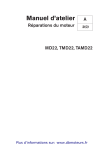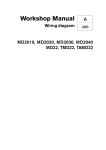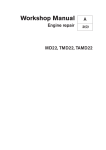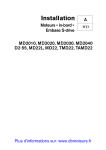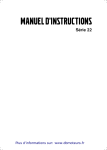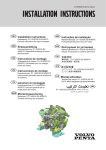Download Volvo Penta TMD22 Technical data
Transcript
Workshop Manual Technical Data A 2(0) MD22, TMD22, TAMD22 Workshop Manual Marine Engines MD22A, MD22L-A, MD22L-B, MD22P-B, TMD22A, TMD22-A, TMD22-B, TMD22P-C, TAMD22P-B Specifications, Technical Data Contents Safety Information ......................................................................................................................... 2 General Information ....................................................................................................................... 5 Specifications ................................................................................................................................ 6 Technical Data: General .................................................................................................................. 6 Cylinder block .................................................................................................................................. 7 Crank movement ............................................................................................................................. 8 Valve mechanism .......................................................................................................................... 10 Lubrication System ........................................................................................................................ 12 Fuel system .................................................................................................................................. 12 Turbocharging system ................................................................................................................... 13 Cooling system .............................................................................................................................. 13 Electrical system ........................................................................................................................... 13 Tightening Torques ........................................................................................................................ 14 1 General instructions Safety information Introduction This Workshop Manual contains technical data, descriptions and repair instructions for Volvo Penta products or product versions contained in the contents list. Ensure that the correct workshop literature is being used. Read the safety information and the Workshop Manual “General Information” and “Repair Instructions” carefully before starting work. Important In this book and on the engine, you will find the following special warning symbols. WARNING! If these instructions are not followed there is a danger of personal injury, extensive damage to the product or serious mechanical malfunction. IMPORTANT! Used to draw your attention to something that can cause damage, product malfunction or damage to property. Note! Used to draw your attention to important information that will facilitate work or operations. Below is a summary of the risks and safety precautions you should always observe or carry out when operating or servicing the engine. Immobilize the engine by turning off the power supply to the engine at the main switch (switches) and lock it (them) in the OFF position before starting work. Set up a warning notice at the engine control point or helm. Generally, all servicing should be carried out with the engine switched off. However, some work, for example certain adjustments, require that the engine is running when they are carried out. Approaching a running engine is dangerous. Loose clothing or long hair can catch in rotating parts and cause serious personal injury. If working in proximity to a running engine, careless movements or a dropped tool can result in personal injury. Avoid burns. Take precautions to avoid hot surfaces (exhausts, turbochargers, charge air pipes and starter elements etc.) and liquids in supply lines and 2 hoses when the engine is running or has been turned off immediately prior to starting work on it. Reinstall all protective parts removed during service operations before starting the engine. Check that the warning or information decals on the product are always clearly visible. Replace decals that have been damaged or painted over. Engines with turbochargers: Never start the engine without installing the air cleaner (ACL) filter. The rotating compressor in the turbocharger can cause serious personal injury. Foreign objects entering the intake ducts can also cause mechanical damage. Never use start spray or similar to start the engine. An explosion may occur in the inlet manifold. Danger of personal injury. Avoid opening the filler cap for engine coolant system (freshwater cooled engines) when the engine is still hot. Steam or hot coolant can spray out. Open the coolant filler cap carefully and slowly to release the pressure before removing the cap completely. Take great care if a cock, plug or engine coolant line must be removed from a hot engine. It is difficult to anticipate in which direction steam or hot coolant can spray out. Hot oil can cause burns. Avoid getting hot oil on the skin. Ensure that the lubrication system is not under pressure before carrying out any work. Never start or operate the engine with the oil filler cap removed, otherwise oil could be ejected. Stop the engine and close the seacock valve before carrying out operations on the engine cooling system. Only start the engine in a well-ventilated area. If operating the engine in an enclosed space, ensure that exhaust gases and crankcase ventilation emissions are ventilated out of the working area. General instructions Always use protective goggles where there is a danger of pieces of metal, sparks from grinding, acid or other chemicals being thrown into your eyes. Your eyes are very sensitive. Injury can lead to loss of sight! Avoid skin contact with oil! Long-term or repeated contact with oil can remove the natural oils from your skin. The result can be irritation, dry skin, eczema and other skin problems. Used oil is more dangerous to health than new oil. Use protective gloves and avoid using oil-soaked clothes and rags. Wash regularly, especially before meals. Use the correct barrier cream to prevent dry skin and to make cleaning your skin easier. Most chemicals used in products (engine and transmission oils, glycol, petrol and diesel oil) and workshop chemicals (solvents and paints) are hazardous to health Read the instructions on the product packaging carefully! Always follow safety instructions (using breathing apparatus, protective goggles and gloves for example). Ensure that other personnel are not unwittingly exposed to hazardous substances (by breathing them in for example). Ensure that ventilation is good. Handle used and excess chemicals according to instructions. Be extremely careful when tracing leaks in the fuel system and testing fuel injection nozzles. Use protective goggles! The jet ejected from a fuel injection nozzle is under very high pressure. It can penetrate body tissues and cause serious injury Danger of blood poisoning. All fuels and many chemicals are inflammable. Ensure that a naked flame or sparks cannot ignite fuel or chemicals. Combined with air in certain ratios, petrol, some solvents and hydrogen from batteries are easily inflammable and explosive. Smoking is prohibited! Ensure that ventilation is good and that the necessary safety precautions have been taken before carrying out welding or grinding work. Always have a fire extinguisher to hand in the workplace. Store oil and fuel-soaked rags and fuel and oil filters safely. In certain conditions, oil-soaked rags can spontaneously ignite. Replaced fuel and oil filters are environmentally harmful waste and should be disposed of at proper disposal areas together with engine and transmission oil, contaminated fuel, old paint, degreasing agents, and cleaning residue. Never allow a naked flame or electric sparks near the batteries. Never smoke in the vicinity of the batteries. The batteries give off hydrogen gas during charging which when mixed with air can form an explosive gas - oxyhydrogen. This gas is easily ignited and highly volatile. Incorrect connection of the battery can cause a single spark which is sufficient to cause an explosion with resulting damage. Do not disturb battery connections when starting the engine (spark risk) and do not lean over batteries. Always ensure that the Plus (positive) and Minus (negative) battery leads are correctly installed on the corresponding terminal posts on the batteries. Incorrect installation can result in serious damage to electrical equipment. Refer to wiring diagrams. Always use protective goggles when charging and handling the batteries. The battery electrolyte contains extremely corrosive sulfuric acid. If this comes into contact with the skin, wash immediately with soap and plenty of water. If battery acid comes into contact with the eyes, immediately flush with copious amounts of water and obtain medical assistance. Turn off the engine and switch off the power at the main switch(es) before carrying out work on the electrical system. 3 General instructions Use the lifting eyes mounted on the engine / reverse gear when lifting the drive unit. Always check that lifting equipment is in good condition and has sufficient load capacity to lift the engine (engine weight including reverse gear and any extra equipment installed). Use an adjustable lifting beam or lifting beam specifically for the engine to raise the engine to ensure safe handling and to avoid damaging engine parts installed on the top of the engine. All chains and cables should run parallel to each other and as perpendicular as possible in relation to the top of the engine. If extra equipment is installed on the engine, thereby altering its center of gravity, a special lifting device is required to achieve the correct balance for safe handling. Never carry out work on an engine suspended on a hoist. Never remove heavy components alone, even where secure lifting equipment such as secured blocks are being used. Even where lifting equipment is being used, it is best to carry out the work with two people; one to operate the lifting equipment and the other to ensure that components are not trapped and damaged when being lifted. When working on-board, ensure that there is sufficient space to remove components without danger of injury or damage. 4 Components in the electrical system, ignition system (gasoline engines) and fuel system on Volvo Penta products are designed and constructed to minimize the risk of fire and explosion. The engine must not be run in areas where there are explosive materials. Always use fuels recommended by Volvo Penta. Refer to the Instruction Book. The use of other grades of fuel can damage the engine. On a diesel engine, poor quality fuel can cause the control rod to seize and the engine to overrev with the resulting risk of damage to the engine and personal injury. Poor fuel quality can also lead to higher maintenance costs. General information About the workshop manual Certificated engines This Service Manual contains technical specifications, descriptions and instructions for the repair of the following engines in standard format: MD22A, MD22L-A, MD22L-B, MD22P-B, TMD22A, TMD22A, TMD22-B, TMD22P-C, TAMD22P-B. This Service Manual can show operations carried out on any of the engines listed above. As a result, the illustrations and pictures in the manual that show certain parts on the engines, do not in some cases apply to all the engines listed above. However, the repair and service operations described are the same in all essential details. Where they are not the same, this is stated in the manual. Where the difference is considerable, the operations are described separately. The engine designation and engine number are displayed on the identification plate. The engine designation and number should be given in all correspondence about the engine. If you own an engine certificated for any area where exhaust emissions are regulated by law, the following is important: Certification means that an engine type is inspected and approved by the authorities. The engine manufacturer guarantees that all engines manufactured of that type correspond to the certified engine. This places special requirements for maintenance and service as follows: • The maintenance and service intervals recommended by Volvo Penta must be observed. • Only genuine Volvo Penta replacement parts may be used. • The service of injection pumps and injectors or pump settings must always be carried out by an authorized Volvo Penta workshop. This Workshop Manual has been developed primarily for Volvo Penta service workshops and qualified personnel. Persons using this book are assumed to have a grounding in marine drive systems and be able to carry out related mechanical and electrical work. • The engine must not be modified in any way except with accessories and service kits approved by Volvo Penta. • No modifications to the exhaust pipes and air supply ducts for the engine room may be undertaken. Volvo Penta is continuously developing their products. We therefore reserve the right to make changes. All the information contained in this book is based on product data available at the time of going to print. Any essential changes or modifications introduced into production or updated or revised service methods introduced after the date of publication will be provided in the form of Service Bulletins. • Seals may only be broken by authorized personnel. Spare parts Replacement parts for electrical and fuel systems are subject to statutory requirements (US Coast Guard Safety Regulations for example). Volvo Penta Genuine parts meet these requirements. Any type of damage which results from the use of nonoriginal Volvo Penta replacement parts for the product will not be covered under any warranty provided by Volvo Penta. In addition, the general instructions contained in the Instruction Manual concerning operation, service and maintenance must be followed. IMPORTANT! Late or inadequate maintenance / service or the use of spare parts other than Volvo Penta original spare parts will invalidate AB Volvo Penta’s responsibility for the engine specification being in accordance with the certificated variant. Volvo Penta accepts no responsibility or liability for any damage or costs arising due to the above. 5 Specifications Technical Data: General No. of cylinders ...................................................... Cylinder configuration ............................................ Cycle ...................................................................... Intake system ........................................................ Combustion system ............................................... Cylinder bore ......................................................... Cylinder stroke ...................................................... Compression ratio MD22 ................................................................. MD22L ............................................................... MD22P, TMD22 ................................................ TAMD22 ............................................................ Compression at starter motor speed ..................... Overall cylinder displacement ............................... Firing order ............................................................ Valve clearances, cold engine:* – Intake ............................................................. – Exhaust .......................................................... * Only adjust if the clearance is outside the limits: – Intake ............................................................. – Exhaust .......................................................... 4 In-line engine Four stroke Naturally aspirated engine or turbocharged Direct injection 84.5 mm 88.9 mm 18.1:1 17.0:1 18.0:1 17.5:1 2100-3500 kPa 1.994 liters 1-3-4-2 0.25-0.35 mm 0.35-0.45 mm 0.20-0.40 mm 0.30-0.50 mm When the cylinder head screws are tightened, the valve clearance reduces by 0.05 mm. If the valve clearance is checked when the cylinder head is not tightened against the cylinder block, the clearances must be as follows: – Intake ............................................................. 0.30/0.40 mm – Exhaust .......................................................... 0.40/0.50 mm If the valve clearance is checked when the cylinder head is not tightened, use the clearances below when calculating shims: – Intake ............................................................. 0.35 mm – Exhaust .......................................................... 0.45 mm Lubricating oil pressure (minimum value at maximum engine speed (RPM) and normal engine coolant temperature (ECT)) ................................................ 250 kPa Direction of rotation ............................................... 6 Clockwise, viewed from in front Specifications Cylinder block Pistons Type ....................................................................... Diameter at piston bolt hole ................................... Distance between height classes Production class 1 to 6 ..................................... Service classes 3 and 6 ................................... Piston height over cylinder block surface ............. Height of groove for the upper ring MD22L, MD22, TMD22 ..................................... TMD22P, TAMD22 ............................................ Height of groove for the 2nd ring MD22L, MD22, TMD22 ..................................... TMD22P, TAMD22 ............................................ Height of groove for the 3rd ring ............................. Oversized piston .................................................... Piston rings Upper compression ring MD22L, MD22, TMD22 ..................................... TMD22P, TAMD22 ............................................ 2nd compression ring .............................................. Oil scraper ring ...................................................... Height, upper ring .......................................................... 2nd ring ............................................................... 3rd ring ............................................................... Play in groove upper ring .......................................................... 2nd ring ............................................................... 3rd ring ............................................................... Ring gap upper ring MD22L, MD22, TMD22 .................... upper ring TMD22P, TAMD22 ........................... 2nd ring MD22L, MD22, TMD22 ........................ 2nd ring TMD22P, TAMD22 ............................... 3rd ring ............................................................... Piston bolts Type ....................................................................... Outer diameter ....................................................... Play in piston bolt position, piston ......................... ”Swirl lip” combustion chamber, controlled expansion, insert for top ring groove, center displaced piston pin 28.004-28.010 mm 0.05 mm 0.15 mm 0.46-0.65 mm 2.10-2.12 mm 3.5 mm 1.81-1.83 mm 2.06-2.08 mm 3.03-3.05 mm 0.50 mm at the diameter Thin shaped (barrel face),molybdenum insert, internal face on top surface. Keystone ring Conical surface, alloy cast iron Spring-loaded, chromed surface 1.978-1.990 mm 1.73-1.74 mm 2.98-2.99 mm 0.11-0.14 mm 0.07-0.10 mm 0.04-0.07 mm 0.28-0.56 mm 0.30-0.50 mm 0.28-0.56 mm 0.60-0.80 mm 0.23-0.56 mm Moving 27.995-28.000 mm 0.004-0.015 mm 7 Specifications Cylinder block Height between the cylinder head surface and contact surface for the bearing cap ....................... Cylinder bore ......................................................... Maximum permitted wear, cylinder bore ............... Oversize, cylinder bore ......................................... Diameter, bearing recess for main bearings ......... Cylinder head Valve seat angle .................................................... Diameter of hole for camshaft ............................... Diameter of hole for valve guides .......................... Diameter of hole for valve lifter ............................. Pressure during leak test ...................................... Maximum permitted cylinder head out-of-true ...... Cylinder head height MD22L, MD22, TMD22 ..................................... TMD22P, TAMD22 ............................................ Permitted machining of cylinder head surface MD22L, MD22, TMD22 ..................................... TMD22P, TAMD22 ............................................ 236.85-236.98 mm 84.442-84.469 mm 0.15 mm 84.942-84.969 mm 60.703-60.719 mm 45° 48.018-48.057 mm 11.98-12.00 mm 31.750-31.775 mm 200 kPa 0.10 mm 120.0-120.1 mm 119.4-119.5 mm 0.20 mm (cylinder head minimum height 119.85 mm) 0.20 mm (cylinder head minimum height 119.25 mm) Crank movement Crankshaft Diameter, main bearing journals ........................... Maximum permitted play and ovality for main bearing journals: .................................................... Width, front bearing journal .......................................... center bearing journal ....................................... other bearing journals ....................................... Diameter, big end journals ..................................... Maximum permitted play and ovality for big end journals: .......................................................... Width, big end journals .......................................... Crankshaft, axial clearance ................................... Diameter, rear flange ............................................. Maximum permitted diameter, rear flange (service) ................................................................. Front stuffing box diameter .................................... Minimum permitted diameter, front stuffing box (service) ................................................................. Diameter, camshaft pulley ..................................... Diameter, socket for guide bearing ....................... Depth, socket for guide bearing ............................ Lower dimensions, main bearings and big end journals ........................................................... 8 56.99-57.01 mm 0.03 mm 27.9-28.6 mm 32.35-32.43 mm 30.5-31.1 mm 53.99-54.01 mm 0.03 mm 27.45-27.65 mm 0.03-0.26 mm 88.84-88.95 mm 88.59 mm 34.965-34.995 mm 34.72 mm 31.98-32.00 mm 28.58-28.60 mm 20.8 mm -0.30 mm Specifications Main bearing shells Type ....................................................................... Bearing width, center bearing ................................................... other bearings ................................................... Bearing thickness .................................................. Inner diameter ........................................................ Bearing clearance .................................................. Permissible lower dimensions of bearings ............ 24.27-24.52 mm 22.35-22.60 mm 1.828-1.835 mm 57.033-57.063 mm 0.023-0.073 mm -0.30 mm Big end bearing shells Type ....................................................................... Thickness .............................................................. Inner diameter ........................................................ Bearing clearance .................................................. Permissible lower dimensions of bearing shells ... Steel coated, copper-lead 1.815-1.825 mm 54.033-54.066 mm 0.023-0.076 mm -0.30 mm Crankshaft thrust washers Type ....................................................................... Position .................................................................. Thickness .............................................................. Steel coated, aluminum solder Both sides of the center bearing 2.31-2.36 mm Connecting rods Type ....................................................................... Diameter, bearing position of the big end shells ... Diameter, bearing position of the connecting rod bushing ............................................................ Distance between bearing centers ........................ Connecting rod bushing Type ....................................................................... Inner diameter (reamed) ........................................ Clearance between connecting rod bushing and piston bolt ........................................................ Steel coated, aluminum tin H-section 57.683-57.696 mm 30.93-30.96 mm 144.98-145.03 mm Steel coated, lead bronze 28.005-28.018 mm 0.05-0.023 mm Alignment of connecting rod (A) The holes for the big end bearing shells and the connecting rod bushing must be at right angles and parallel with each other within a ± 0.25 mm tolerance, measured with a mandrel at a distance of 127 mm on each side of the connecting rod. With the connecting rod bushing installed, the tolerance is reduced to ± 0.06 mm. Flywheel Maximum radial runout .......................................... Max. axial runout for every 25th mm radial clearance between the crankshaft and the gauge tip on the indicator. ..................................................... Flywheel cover Concentric and parallel limits ................................ 0.30 mm total read off on the dial indicator 0.03 mm total read off on the dial indicator 0.15 mm total read off on the dial indicator 9 Specifications Valve mechanism Valve guides Inner diameter (reamed in position) ...................... Outer diameter ....................................................... Valve guide interference in cylinder head ............. Intake valves Valve stem diameter .............................................. Clearance valve stem – valve guide ..................... Maximum permitted clearance valve stem – valve guide ..................................................... Valve crown diameter ............................................ Valve contact angle ............................................... Total length ............................................................ Sealing equipment .................................................. Valve crown depth position under cylinder head face MD22L, MD22, TMD22 ..................................... TMD22P, TAMD22 ............................................ Exhaust valves Valve stem diameter .............................................. Clearance valve stem – valve guide ..................... Maximum permitted clearance valve stem – valve guide ..................................................... Valve crown diameter ............................................ Valve contact angle ............................................... Total length ............................................................ Sealing equipment .................................................. Valve crown depth position under cylinder head face MD22L, MD22, TMD22 ..................................... TMD22P, TAMD22 ............................................ 7.450-7.463 mm 12.04-12.06 mm 0.04-0.08 mm 7.41-7.42 mm 0.03-0.05 mm 0.13 mm 37.10-37.25 mm 44° 30´ (91° total angle) 93.72 - 93.97 mm Rubber seal installed on the valve guide. 0.90-1.24 mm 0.25-0.59 mm 7.39-7.41 mm 0.04-0.07 mm 0.13 mm 33.55-33.70 mm 44° 30´ (91° total angle) 93.72- 93.97 mm Rubber seal installed on the valve guide. 1.30-1.64 mm 0.65-0.91 mm Valve springs Installed length ....................................................... Spring loading when installed ................................ Number of active spring coils ................................ Number of damper coils ........................................ Direction of winding ............................................... Color coding ........................................................... 34.7 mm 198 N 4.5 0 Left Orange Valve lifters and shims Material .................................................................. Outer diameter of valve lifter ................................. Valve lifter clearance in cylinder head .................. Thickness of the head of the valve lifter ............... Total length ............................................................ Thickness of shims ................................................ Steel 31.725-31.745 mm 0.005-0.050 mm 6.85-6.93 mm 25.7-26.3 mm Series of shims from 2.286 mm to 3.400 mm 10 Specifications Camshaft Diameter of front and rear bearing journal ............ Diameter of center bearing journal ........................ Clearance of the bearing journals in the holes: – Front and rear ................................................ – Center ............................................................ Diameter of pulley hub ........................................... Cam lift, at 0 mm valve clearance (intake/exhaust) MD22L ............................................................... MD22P, TMD22, TAMD22 ................................ Axial clearance ...................................................... Maximum permitted axial clearance in operation .. Depth of socket for thrust washer ......................... 47.693-47.975 mm 47.958-47.975 mm 0.043-0.094 mm 0.043-0.099 mm 36.58-36.61 mm 9.1/9.4 mm 9.6/9.6 mm 0.11-0.27 mm 0.50 mm 6.06-6.12 mm Camshaft thrust washer Type ....................................................................... Thickness .............................................................. Installation parameter for thrust washer in socket in camshaft cover ...................................... ± 0.05 mm Pulley for crankshaft Number of teeth ..................................................... Hole diameter ......................................................... Pulley clearance on crankshaft ............................. 24 32.010-32.035 mm 0.010-0.055 mm Pulley and hub for crankshaft Number of teeth ..................................................... Hole diameter in hub .............................................. Hub clearance on crankshaft ................................. 48 36.62-36.65 mm 0.01-0.07 mm Pulley for fuel injection pump Number of teeth ..................................................... Hole ........................................................................ Setting tooth and marking letter MD22, MD22L ................................................... TMD22, TAMD22 .............................................. Idler pulley for timing belt Outer diameter ....................................................... Internal radial clearance ........................................ Tension pulley for timing belt Outer diameter ....................................................... Internal radial clearance ........................................ Timing belt tension (according to gauge) New belt ............................................................ If the tension of the existing (used) belt has fallen to 270 N or lower, adjust to ..................... 180° washer installed in camshaft cover 5.90-5.95 mm 48 Conical “A” “B” 79.8-80.2 mm 0.005-0.025 mm 59.8-60.2 mm 0.005-0.025 mm 425-465 N 340-370 N 11 Specifications Lubrication system Lubricating oil pump Type ....................................................................... crankshaft Number of teeth ..................................................... Clearance, outer rotor-housing ........................................... inner rotor-outer rotor ....................................... Axial clearance, inner rotor ......................................................... outer rotor ......................................................... Relief valve, oil pressure Valve opening pressure ......................................... Hole diameter, control sleeve ................................ Outer diameter, plunger ......................................... Clearance plunger-sleeve ...................................... Spring length (integrated) ...................................... Spring loading (integrated) .................................... Differential rotor, installed around the front end of the Inner rotor 10, outer rotor 11 0.30-0.36 mm 0.025-0.082 mm 0.030-0.075 mm 0.05-0.10 mm 414 kPa 14.21-14.25 mm 14.160-14.186 mm 0.024-0.090 mm 30.4 mm 51.1 N Fuel system Injection pump Make ...................................................................... Type ....................................................................... Rotational direction, (viewed from drive end) ....... Exit point for cylinder 1 .......................................... Pump element lift, motor TDC MD22 ................................................................. MD22L ............................................................... TMD22............................................................... TMD22P ............................................................ TAMD22 ............................................................ Bosch EPVE Clockwise “A” 1.37 ±0.02 mm 1.42 ±0.02 mm 1.26 ±0.02 mm 1.22 ±0.02 mm 1.10 ±0.02 mm Injector Opening pressure, MD22L (Code RG) ............................................ MD22 (Code JD) ............................................... TMD22 (Code JC) ............................................. TMD22P, TAMD22 (Code RY) .......................... 22.8+10 MPa 22.8+10 MPa 22.8 ±5 MPa 23.5 ±5 MPa Feed pump Type ....................................................................... Drive method ......................................................... Static pressure (no power supply) ........................ A.C. Delco, type YD Eccentric from camshaft 41-69 kPa Fuel filter Make ...................................................................... Type ....................................................................... Bosch Spin-on 12 Specifications Turbocharging system Turbocharger (TC) Make ...................................................................... Lubrication system ................................................ Garret Force-feed lubrication from the engine Cooling system Circulation pump Type ....................................................................... Centrifugal pump, belt driven Sea water pump Make ...................................................................... Type ....................................................................... Drive ....................................................................... Jabsco Rubber impeller Belt drive Thermostat Type ....................................................................... Starts opening at .................................................... Fully open at .......................................................... Valve lift height, fully open .................................... Wax filled thermostat, by-pass version 77°-85°C 92°-98°C 9.1 mm Electrical system Generator Make ...................................................................... Type ....................................................................... Marking data .......................................................... Direction of rotation ............................................... Starter motor Make ...................................................................... Type ....................................................................... Voltage ................................................................... Number of teeth on the drive ................................. Maximum resistance of engine starter cable at 20°C .............................................................. Brush length: New ................................................................... Minimum permissible, used .............................. Glow plugs Make ...................................................................... Current after 20 seconds ....................................... Probe length ........................................................... Valeo A13N 147M 12V/60A (early version 12V/50A) Clockwise, viewed from drive end Lucas M80R 12V 10 0.0017 ohm 9.0 mm 3.5 mm Bosch 12A 23 mm 13 Specifications Tightening torque Thread Torque (Nm)’ Cylinder head assembly Bolts, cylinder head ............................................... Bolts, camshaft cover ............................................ M 12 M8 (see next page) 22 Piston and connecting rod assembly Nuts, big ends ........................................................ 11/32 UNF 47 Crankshaft assembly Screws, main bearing ............................................ Screws, crankshaft pulleys ................................... Domed screws, crankshaft pulley ......................... Screws, housing for rear stuffing box ................... M 12 M 14 M6 M 10 112 180 10 43 Screws, hub for camshaft pulley ........................... Screws, camshaft pulley to hub ............................ Domed screw, tension pulley ................................ Screws, idler pulley ............................................... M5 M6 M8 M 12 M8 M 10 M 10 3 6 10 85 22 43 43 Intake system Screws, intake and exhaust manifold .................... M8 22 Screws, rear face of oil pump ................................ Screws, filter head to oil pump .............................. Screws, lubricating oil sump ................................. 1/4 BSP M6 M8 M4 M8 M6 43 9 22 4 22 12 Fuel injection system Nuts, high pressure fuel lines ................................ Screws, injector holder .......................................... Fuel feed pump screws ......................................... Screws, mounting bracket for fuel injection pump Nut, pulley for injector pump ................................. Nuts for flange for fuel injection pump .................. M 12 M 10 M8 M 10 M 14 M8 18 43 22 43 60 22 M8 M10 M6 M6 M 10 22 48 9 9 43 7/16 UNF M8 M 10 M 12 65 22 43 81 M 17 M 12 60 20 Timing cover and drive Screws, timing cover ............................................. Lubrication system Plug, lubricating oil sump ...................................... Screws, lubricating oil pump ................................. Cooling system Screws, water pump .............................................. Screws, seawater pump ........................................ Domed screws, drive adapter for seawater pump Flywheel and flywheel housing Screws, flywheel to crankshaft ............................. Screws, flywheel housing ...................................... Electrical system Nuts, generator (GEN) pulley ................................ Glow plugs ............................................................. * The above tightening torques apply to components lightly lubricated with clean engine oil prior to installation. 14 Specifications Cylinder head screws Tighten the screws in 3 stages according to diagram A. 1st tightening: 50 Nm 2nd tightening: 100 Nm 3 rd tighten by 90° in one operation Tightening diagram 15 Notes .................................................................................................................................................................................... .................................................................................................................................................................................... .................................................................................................................................................................................... .................................................................................................................................................................................... .................................................................................................................................................................................... .................................................................................................................................................................................... .................................................................................................................................................................................... .................................................................................................................................................................................... .................................................................................................................................................................................... .................................................................................................................................................................................... .................................................................................................................................................................................... .................................................................................................................................................................................... .................................................................................................................................................................................... .................................................................................................................................................................................... .................................................................................................................................................................................... .................................................................................................................................................................................... .................................................................................................................................................................................... .................................................................................................................................................................................... .................................................................................................................................................................................... .................................................................................................................................................................................... .................................................................................................................................................................................... .................................................................................................................................................................................... .................................................................................................................................................................................... .................................................................................................................................................................................... .................................................................................................................................................................................... .................................................................................................................................................................................... .................................................................................................................................................................................... .................................................................................................................................................................................... .................................................................................................................................................................................... .................................................................................................................................................................................... .................................................................................................................................................................................... .................................................................................................................................................................................... .................................................................................................................................................................................... .................................................................................................................................................................................... .................................................................................................................................................................................... .................................................................................................................................................................................... .................................................................................................................................................................................... Report form Do you have any complaints or other comments about this manual? Please make a copy of this page, write your comments down and post it to us. The address is at the bottom of the page. We would prefer you to write in English or Swedish. From: ............................................................................ ...................................................................................... ...................................................................................... ...................................................................................... Refers to publication: ............................................................................................................................................. Publication no.: ..................................................................... Issued: .................................................................... Suggestion/reasons: .............................................................................................................................................. .............................................................................................................................................................................. .............................................................................................................................................................................. .............................................................................................................................................................................. .............................................................................................................................................................................. .............................................................................................................................................................................. .............................................................................................................................................................................. .............................................................................................................................................................................. .............................................................................................................................................................................. Date: ........................................................... Name: ......................................................... AB Volvo Penta Customer Support Dept. 42200 SE-405 08 Gothenburg Sweden 7740079-4 English 02-1999




















